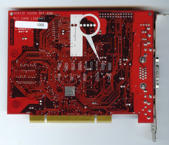First post, by swaaye

Speedy3D (DOS) / RRedline (Win9x) games:
3D Accelerated Games List (Proprietary APIs - No 3DFX/Direct3D)
Video and screenshots
V1000 game screens https://www.mediafire.com/folder/2z0yr501x6mt … Rendition_V1000
V2000 game screens https://www.mediafire.com/folder/pa4jop6s7fd3 … Rendition_V2000
YouTube playlist
Info
Renaddiction - old Rendition fan site (Archive.org)
Post on Usenet from a Rendition programmer. Describes VQuake development and issues, V1000 vs V2200, Quake engine workings, etc.
Downloads
https://www.vogonsdrivers.com/
PHOTOS
- Rendition V1000 Reference PCI 4MB


- Sierra Screamin' 3D V1000 4MB PCI
-Sierra the game company. They liked to help push new game tech that they thought was the future.
-Made by Canopus and possibly Identical to Canopus Total 3D.

- Intergraph Reactor / Intense 3D 100 V1000 4MB PCI

- Creative Labs 3D Blaster PCI V1000 4MB PCI



- Miro MiroCrystal VRX

- V2200 Reference Design 4MB PCI. All the extras.


- Diamond Stealth II S220 V2100 4MB PCI
-The only V2100 card. A BIOS update overclocked it to V2200 speeds without issue
-Sold for $50 direct at the end. First way-cheap 3D card that was usable. :)


- Genoa V-Raptor PCI

- Hercules Thriller 3D V2200 4MB PCI


- QDI Vision 1 V2200 AGP

- Jazz Multimedia Bonny & Clyde V2200 AGP & PCI

Q&A
- What is unique about Verite graphics chips?
They are somewhat different in the architectural sense compared to other chips. Their processing is based both on running microcode on an internal MIPS-based RISC processor and on dedicated pixel pipeline hardware. The microcode aspect allowed Rendition to add features (within limits) as realtime 3D developed.
The chips also support VGA, 2D GUI, and video acceleration although it is not as fast as some other graphics cards of the time. The V1000 cards were the best 2D+3D cards of their time, and the V2x00 cards were very competitive with their peers.
Oh and V2x00 can output 24-bit color in 3D. - What cards competed with V1000? (1995-96)
Matrox Mystique, ATI 3D Rage I/II, NVIDIA NV1, S3 ViRGE, PowerVR PCX1/2, 3Dfx Voodoo Graphics. - What cards competed with V2x00? (1997-98)
Matrox G200, ATI 3D Rage Pro, NVIDIA RIVA 128 / TNT, S3 ViRGE DX/GX, S3 Trio3D, S3 Savage 3D, 3Dfx Voodoo Graphics & Voodoo2. - What's the difference between the V1000E and the V1000L?
The V1000E chip is based upon a 5V process. The V1000L is made with a 3.3V process and hence dissipates less power at a given clock frequency. Therefore it can be clocked at a higher frequency and as a result performs somewhat better. Otherwise, the two chips are identical.
Benchmark results:
https://gona.mactar.hu/v1000/ - Is V1000 faster than Voodoo1? ViRGE?
V1000 can be faster if the CPU is slow enough. This is because V1000 fully offloads the triangle setup step of the rendering process and it uses DMA transfers, unlike Voodoo1. However, in general, V1000's capabilities are are vastly inferior to Voodoo1 as evidenced by its inability to run most OpenGL and D3D 5+ games.
V1000 and Virge may be somewhat similar but I think V1000 is generally superior. Neither is particularly good with Direct3D or OpenGL games, but like V1000, Virge had its own 3D API called S3D and games that used this ran pretty well. - Is V2x00 faster than Voodoo1?
Yes it is faster and it can produce superior image quality due to sharper texture filtering and the ability to use 24-bit color depth. But driver bugs frequently put a damper on V2000's quality. - How much faster is V2x00 compared to V1000?
Over twice as fast. It has over twice the fillrate and additional effects don't have the same performance impact. - Are the V2x00 boards compatible with games written for the V1000?
Some early Speedy3D (DOS) games will only recognize V1000 and need a patch. There is a utility called V2DOSFIX to fix games that were never patched. link - Is AGP beneficial with V2x00?
The chips only use AGP as a 66 MHz PCI bus, just like 3dfx cards. - Is 8MB tangibly better for V2x00?
Yes because it allows for higher resolutions in both 2D and 3D (if performance allows). - Is VQuake superior to GLQuake?
No. VQ has a few interesting advantages such as anti-aliasing, but the overall visual quality is lower and there is no support for transparent water. VQ came first, however. Also, obviously GLQuake is free for everyone to support while VQuake is proprietary for Rendition. - How is DOS VGA support?
VESA support is good and performs quite well. Plain VGA modes are, however, very slow. There is a utility called "RenUtil" which remaps regular VGA to a VESA mode, but this doesn't work for ModeX (like lots of DOS FPS games). - How is Windows GUI speed?
It's ok. It's accelerated but not as fast as the fastest competitors of the time. V2x00 is faster but still rather slow compared to say Matrox G200 or NVIDIA TNT. - How is the output signal quality?
It varies but unfortunately these cards will typically get fuzzy at resolutions above 1024x768. Their typical 4MB RAM limits them to around 1024x768 for good color depth anyway. - How is OpenGL support?
Not great, as with most vendors back then. Rendition did eventually release a functional MiniGL for Quake and Quake descended games (i.e. Half Life). A full OpenGL ICD is also available but it is slow and buggy. The lack of per-pixel mip mapping is unfortunate. Also, V1000 is not well suited to OpenGL in general. - How is D3D support?
V1000 was actually sort of a reference model for MS when designing D3D. It was the first consumer hardware that could render D3D's feature set. At one point, requesting information about D3D driver development would get you V1000 source code. But there are some issues with V1000 and D3D regardless of this.
Very old D3D games don't work well with DMA, and this cripples V1000 because processing parallelism breaks down. Also since D3D and drivers for it were rapidly evolving, new bugs would appear and they would also break features that worked previously. This was just part of the fun with all hardware back then. - How do I play Unreal?
You should use the OpenGL renderer included with later versions of the game. This renderer was built with V2200 in mind. - Is there 3DNow! support?
The OpenGL ICD readme mentions some 3DNow! support but there's no info on how thorough it is.



 [/img]
[/img]
